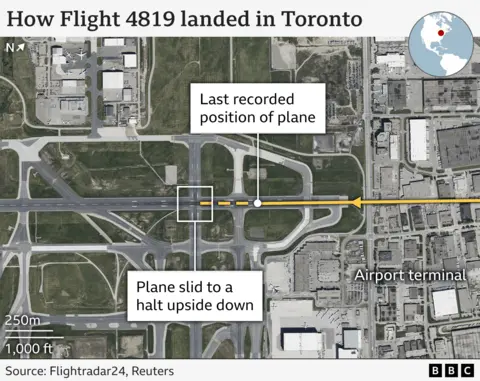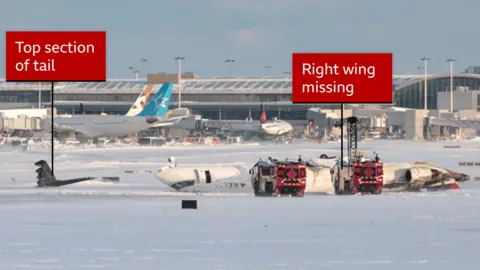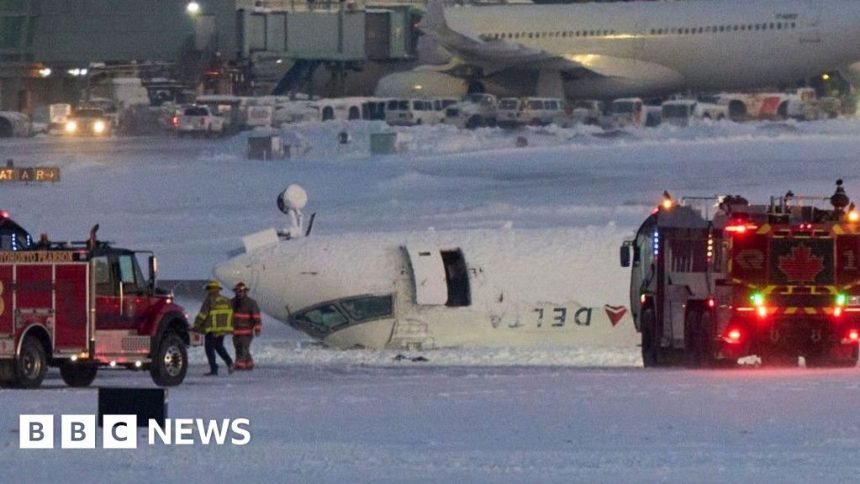Why did a plane crash in Toronto, and how did everyone survive?
No deaths have been reported after a plane landing in Toronto from the US skidded along the runway and flipped over, with flames visible for a brief time.
It is not clear what caused the incident, with analysts suggesting that the weather may have played a role, or that the aircraft struck something.
An investigation is under way.
What happened when the plane crashed?
The incident took place shortly after 14:00 local time on Monday (19:00 GMT).
It involved a model CRJ-900 plane, operating as Delta Air Lines flight DL4819.
The aircraft arrived at Toronto from the US city of Minneapolis and was carrying 76 passengers and four crew members.
As it landed, the plane appears to have struck the runway, slid for some distance and then flipped over, observed Dan Ronan, a journalist and pilot licensed by the US Federal Aviation Administration (FAA) who spoke to BBC News.

Footage obtained by TMZ showed part of the aircraft bursting into flames as the landing happened. Firefighters rushed to put these out.
Passenger Pete Carlson told broadcaster CBC it was “a very forceful event”, recalling the sound of “concrete and metal” at the moment of impact.
He and others on board were suspended upside down in their seats, and had to release themselves onto the cabin ceiling before leaving the inverted aircraft.
All 80 people on board survived. There were 18 injuries, of which only a small number are thought to be serious.
Delta has promised to give more updates.
How does a plane flip over?
The right wing may have struck the runway or an item on it, such as a light, Mr Ronan suggested.
The weather may also have been significant. The airport fire chief stated that the runway was dry at the time of the incident.
Airport authorities had said earlier that although recent heavy snow had stopped, “frigid temperatures and high winds [were] moving in”.
As the plane came in to land, air traffic controllers told the pilots of 38mph (61km/h) gusts and the possibility of a “slight bump in the glide path”, CNN reported.
The pilots appear to have attempted what is known as a crab manoeuvre, Mr Ronan said. This involves turning a plane into the wind, and then directly onto the runway at the last moment.
Marco Chan, a former pilot and a senior lecturer at Buckinghamshire New University in the UK, agreed that the aircraft was banking to the right, and appeared to have made a hard landing – meaning a high rate of descent.
It seems to have touched down with one wheel first, Mr Chan told the BBC, which might have caused the landing gear to collapse on impact. This could have lead to the right wing hitting the runway and in turn causing the plane to roll.
How did everybody on board the plane survive?
“The sheer survivability of this is really amazing,” Mr Ronan told the BBC, pointing out that the aeroplane’s fuselage (body) had stayed intact.
He also highlighted the importance of the plane’s high-impact 16G seats, which he said were “designed to absorb a great deal of punishment”.
Other commentators hailed the importance of safety features. CNN analyst and former FAA inspector David Soucie said the plane had broken apart as it had meant to, with the detachment of at least one wing stopping the fuselage ripping apart.
Graham Braithwaite, professor of safety and accident investigation at the UK’s Cranfield University, said planes were also designed so that air passengers involved in an accident did not hit things likely to cause injury.
“Even the design of the seat back or the tray table is all part of how we consider making that survivable space,” he told the BBC. “And the seatbelt that people have is so important – that is the ultimate thing that stops people being thrown around the cabin like this,” he added.

The flight attendants have also been praised for getting everyone off the flipped aeroplane quickly. Emergency crews on the ground were labelled “heroic” by the airport chief after reaching the crash site in a matter of minutes.
Mr Carlson said the passengers themselves had worked together very effectively. “What I saw was everyone on that plane suddenly became very close in terms of how to help one another, how to console one another,” he said.
Which other plane crashes have happened recently?
This marks the fourth major air crash in North America in less than a month, and other recent incidents remain under investigation.
- All 67 people on board a passenger aeroplane and military helicopter died after the two aircraft collided in mid-air near Washington DC on 29 January
- Seven people were killed on 1 February when a medical transportation plane carrying six people crashed in Philadelphia. Another person was killed on the ground
- All 10 people were killed when a small plane came down in Alaska on 6 February
Those incidents followed another high-profile crash in South Korea in December, in which 179 people were killed.
Despite these, experts say air travel remains overwhelmingly safe – and increasingly so.
The US National Transportation Safety Board (NTSB) says there were 257 fatal accidents in the US in 2024, compared with 362 in 2014.
Additional reporting by Tom Joyner and Josh Cheetham








